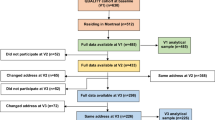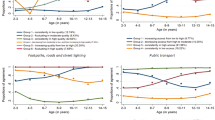Abstract
Objective:
The objective of this study is to examine associations between aspects of the environment in school neighborhoods and childhood body mass index percentile (BMIp).
Methods:
Trained medical students visited 46 elementary schools in the Kansas City metropolitan area to conduct medical screenings that included the height and weight measurements of 12 118 boys and girls 4–12 years of age in the academic year 2008–2009. For the same time period, aspects of the built environment in a 2-mile radius around each school was obtained from the Walkscore database. Other environmental characteristics (for example, population change) of these areas were also obtained from various sources. Hierarchical linear modeling was used to estimate the associations between neighborhood- and individual-level factors and BMIp.
Results:
Population size along with the number of fast-food restaurants and grocery stores were positively associated with BMIp, whereas population change along with the number of parks and fitness centers were inversely associated with BMIp.
Conclusions:
After considering individual-level factors and the random effects of schools, environmental elements of school neighborhoods predict childhood BMIp. This study offers evidence of the health influence of school neighborhoods in a way that can inform neighborhood redevelopment efforts.
This is a preview of subscription content, access via your institution
Access options
Subscribe to this journal
Receive 12 print issues and online access
$259.00 per year
only $21.58 per issue
Buy this article
- Purchase on Springer Link
- Instant access to full article PDF
Prices may be subject to local taxes which are calculated during checkout

Similar content being viewed by others
References
Ogden CL, Carroll MD, Kit BK, Flegal KM . Prevalence of obesity and trends in body mass index among US children and adolescents, 1999–2010. JAMA 2012; 307: 483–490.
Veitch J, Salmon J, Ball K . Children’s active free play in local neighborhoods: a behavioral mapping study. Health Ed Res 2008; 23: 870–879.
Maffeis C, Tato L . Long-term effects of childhood obesity on morbidity and mortality. Horm Res 2001; 55: 42–45.
Salmon J, Timperio A, Cleland V, Venn A . Trends in children’s physical activity and weight status in high and low socio-economic status areas of Melbourne, Victoria: 1985–2001. Aust NZ J Public Health 2005; 29: 337–342.
Wang L, Lobstien T . Worldwide trends in childhood over-weight and obesity. Int J Pediatr Obes 2006; 1: 1–64.
Cockerham WC . Health lifestyle theory and the convergence of agency and structure. J Health Soc Beh 2005; 46: 51–67.
Bourdieu P . Logic of Practice. Stanford University Press: Stanford, CA, USA, 1990.
Lovasi GS, Hutson MA, Guerra M, Neckerman KM . Built environments and obesity in disadvantaged populations. Epi Rev 2009; 31: 7–20.
Cockerham WC . Social Causes of Health and Disease. Polity Press: Malden, MA, USA, 2007.
Ball K, Timperio A, Crawford D . Understanding environmental influences on nutrition and physical activity behaviors: where should we look and what should we count? Int J Behav Nutr Phys Act 2006; 3: 33.
Papas MA, Alberg AJ, Ewing R, Helzlsouer KJ, Gary TL, Klassen AC . The built environment and obesity. Epidemiol Rev. 2007; 29: 129–143.
Bedimo-Rung AL, Mowen AH, Cohen DA . The significance of parks to physical activity and public health: a conceptual model. Am J Prev Med. 2005; 28: 159–168.
Dunton GF, Kaplan J, Wolch J, Jerrett M, Reynolds KD . Physical environmental correlates of childhood obesity: a systematic review. Obes Rev. 2009; 10: 393–402.
Epstein LH, Raja S, Gold SS et al. Reducing sedentary behavior: the relationship between park area and the physical activity of youth. Psychol Sci. 2006; 17: 654–659.
Galvez MP, Pearl M, Yen IH . Childhood obesity and the built environment. Curr Opin Pediatr. 2010; 22: 202–207.
Rahman T, Cushing RA, Jackson RJ . Contributions of built environment to childhood obesity. Mt Sinai J Med. 2011; 78: 49–57.
Sallis J, Bauman A, Pratt M . Environmental and policy interventions to promote physical activity. Am J Prev Med. 1998; 15: 379–395.
Swinburn B, Caterson I, Seidall J, James W . Diet, nutrition and prevention of excess weight gain and obesity. Pub Health Nutr 2004; 7: 123–146.
Burdette HL, Whitaker RC . Neighborhood play-grounds, fast food restaurants, and crime: relationships to overweight in low-income preschool children. Prev Med. 2004; 38: 57–63.
Neumark-Sztainer D, French SA, Hannan PJ, Story M, Fulkerson JA . School lunch and snacking patterns among high school students: associations with school food environment and policies. Int J Behav Nutr Phys Act. 2005; 2: 14.
Liu G, Wilson J, Qi R, Ying J . Green neighborhoods, food retail and childhood overweight: differences by population density. Am J Health Promot 2007; 21: 317–325.
Morland K, Diez Roux AV, Wing S . Supermarkets, other food stores, and obesity: the atherosclerosis risk in communities study. Am J Prev Med 2006; 30: 333–339.
Powell L, Auld C, Chaloupka F, O’Malley PM, Johnston LD . Associations between access to food stores and adolescent body mass index. Am J Prev Med. 2007; 33: S301–S307.
Kipke M, Iverson E, Moore D, Booker C, Ruelas V, Peters AL et al. Food and park environments: neighborhood-level risks for childhood obesity in East Lost Angeles. J Adol Health 2007; 40: 325–333.
Feng J, Glass TA, Curriero FC, Stewart WF, Schwartz BS . The built environment and obesity: a systematic review of the epidemiologic evidence. Health Place 2010; 16: 175–190.
Cohen D, Scott M, Wang FZ, McKenzie TL, Porter D . School design and physical activity among middle school girls. J Phys Act Health 2008; 5: 719.
Ding D, Sallis J, Kerr J, Lee S, Rosenberg D . Neighboorhood environment & physical activity among youth. Am J Prev Med. 2011; 41: 422–455.
Casagrande SS, Whitt-Glover MC, Lancaster KJ, Odoms-Young AM, Gary TL . Built environment and health behaviors among African Americans: a systematic review. Am J Prev Med. 2009; 36: 174–181.
Papas MA, Alberg AJ, Ewing R, Helzlsouer KJ, Garry TL, Klassen AC . The built environment and obesity. Epidemiol Rev 2007; 29: 129–143.
Panter JR, Jones AP, Van Sluijs EMF, Griffin SJ . Neighborhood, route, and school environments and children’s active commuting. Am J Prev Med. 2010; 38: 268–278.
Timperio A, Crawford D, Telford A, Salmon J . Perceptions about the local neighborhood and walking and cycling among children. Prev Med. 2004; 38: 39–47.
Timperio A, Ball K, Salmon J, Roberts R, Simmons D, Baur LA et al. Personal, family, social, and environmental correlates of active commuting to school. Am J Prev Med. 2006; 30: 45–51.
van Sluijs EMF, Fearne VA, Mattocks C, Riddoch C, Griffin SJ, Ness A . The contribution of active travel to children’s physical activity levels: cross- sectional results from the ALSPAC study. Prev Med. 2009; 48: 519–524.
Schlossberg M, Greene J, Phillips PP, Johnson B, Parker B . School trips: effects of urban form and distance on travel mode. J Am Plan Assoc 2006; 7: 337–346.
Mccormack G, Giles-Corti B, Lange A, Smith T, Martin K, Pikora TJ . An update of recent evidence of the relationship between objective and self- report measures of the physical environment and physical activity behaviors. J Sci Med Sport/Sports Med Aust 2004; 7: 81–92.
Austin SB, Melly SJ, Sanchez BN, Patel A, Buka S, Gortmaker SL . Clustering of fast-food restaurants around schools: a novel application of spatial statistics to the study of food environments. Am J Public Health. 2005; 95: 1575–1581.
Zenk SN, Powell LM . United States secondary schools and food outlets. Health Place 2008; 14: 336–346.
Davis B, Carpenter C . Proximity of fast-food restaurants to schools and adolescent obesity. Am J Pub Health 2009; 99: 505–510.
Maddock J . The relationship between obesity and the prevalence of fast food restaurants: state-level analysis. Am J Health Promot 2004; 19: 137–143.
Seliske LM, Pickett W, Boyce WF, Janssen I . Association between the food retail environment surrounding schools and overweight in Canadian youth. Pub Health Nutr 2009; 12: 1384–1391.
Sturm R, Datar A . Body mass index in elementary school children, metropolitan area food prices and food outlet density. Pub Health 2005; 119: 1059–1068.
Jones NR, Jones A, van Sluijs EMF, Panter J, Harrison F, Griffin SJ . School environments and physical activity: the development and testing of an audit tool. Health Place. 2010; 16: 776–783.
Webber LS, Johnson CC, Rose D, Rice JC . Development of ACTION! Wellness program for elementary school personnel. Obesity 2007; 15: 48S–56S.
Harrison F, Jones AP . A framework for understanding school based physical environmental influences on childhood obesity. Health Place. 2012; 18: 639–648.
Ward TCS, Mori N, Patrick T, Madsen MK, Cisler RA Influence of socioeconomic factors and race on birth outcomes in urban Milwaukee. Wisc Med J 2010; 109: 254–260.
Wu CC, Hsu TW, Chang CM, Yu CH, Wang YF, Lee CC . The effect of individual and neighborhood socioeconomic status on gastric cancer survival. PLos One 2014; 9: e89655.
Centers for Disease Control: http://www.cdc.gov/nccdphp/dnpao/growthcharts/resources/sas.htm.
Raudenbush SW, Bryk AS . Hierarchical Linear Models: Applications and Data Analysis Methods. Sage Publications: Thousand Oaks, CA, USA, 2002.
Krull JL, MacKinnon DP . Multilevel modeling of individual and group level mediated effects. Multivar Beh Res 2001; 36: 249–277.
Braza M, Shoemaker W, Seeley A . Neighborhood design and rates of walking and biking to elementary school in 34 California communities. Am J Health Promot 2004; 19: 128–136.
Acknowledgements
We would like to thank Annette Campbell, Katherine Braunlich and Arthur Kheyfets for their support and assistance with this article.
Author information
Authors and Affiliations
Corresponding author
Ethics declarations
Competing interests
The authors declare no conflicts of interest.
Rights and permissions
About this article
Cite this article
Wasserman, J., Suminski, R., Xi, J. et al. A multi-level analysis showing associations between school neighborhood and child body mass index. Int J Obes 38, 912–918 (2014). https://doi.org/10.1038/ijo.2014.64
Received:
Revised:
Accepted:
Published:
Issue Date:
DOI: https://doi.org/10.1038/ijo.2014.64
Keywords
This article is cited by
-
Socio-economic and Regional Differences in Walkability and Greenspace Around Primary Schools: A Census of Australian Primary School Neighbourhoods
Journal of Community Health (2021)
-
The relationship between unhealthy food sales, socio-economic deprivation and childhood weight status: results of a cross-sectional study in England
International Journal of Behavioral Nutrition and Physical Activity (2016)
-
A cross sectional study investigating the association between exposure to food outlets and childhood obesity in Leeds, UK
International Journal of Behavioral Nutrition and Physical Activity (2014)



